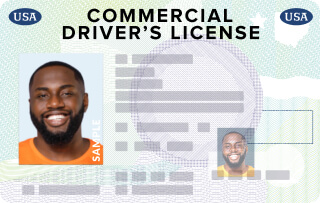- Updated for April 2025
- Based on 2025 CO commercial driver's license manual
Free Colorado CDL Combination Practice Test 2025
Welcome! You’re probably here because you want to pass the official Combination Vehicles knowledge test on the theory of operating combination vehicles, which you must do to be allowed to drive semi-trucks and tractor-trailers. We hope you’ve been reading the official Colorado Commercial Driver License Manual (Colorado CDL Handbook 2025), especially Section 6 (Combination Vehicles), because the official knowledge test is based on it. But are you also looking for some additional help to improve your chances of passing the test?
Well, that’s what we’re here for! We’ve helped thousands of aspiring car drivers and commercial drivers pass their respective knowledge exams, and we’re going to help you too.
This free Colorado CDL Combination practice test, one of several we offer, is based on the above official study guide, just like the official Combination Vehicles knowledge test. The practice test is up to date as of April, 2025. As you practice answering questions about the stuff you’ve been reading in the manual, that material will become easier to remember, increasing your chances of passing the official exam. To make your learning easier, each of the 25 practice questions comes with a helpful hint and an explanation of the correct answer. The practice questions and answers on this test will assess your knowledge of such topics as safe driving techniques, combination braking systems, coupling and uncoupling, and pre-trip inspections. If you need help to answer a question, our automated assistant can give you a hint. If you still miss the question, the assistant can provide you with an explanation of the correct answer.
Once you obtain a Commercial Learner’s Permit (CLP), you can start practicing commercial driving of combination vehicles until you get good enough to pass the official skills test. Passing the skills test in a combination vehicle is a necessary step toward obtaining a Class A Commercial Driver’s License (CDL).
Once you hold a Class A CDL, you can start earning real money as a licensed driver of combination vehicles. Economic sectors in Colorado’s diversified economy include agriculture (hay, corn, wheat, and beef), aerospace, manufacturing, and gold mining and production. All these sectors need truck drivers to transport their products. The aerospace and mining industries also need truck drivers to deliver equipment and supplies to them.
You’ll soon become familiar with Colorado’s major truck routes. Here are some. Interstate 25, heavily used by truckers, runs from Wyoming through Denver and then to New Mexico. Interstate 70 runs from Utah to Maryland. Interstate 76 and U.S. Route 285 are heavily used by truckers to transport agricultural products.
- Perfect for first-time and renewal CDL/CLP applicants, and those adding endorsements
- Triple-checked for accuracy
What you need to know

What to expect on the actual CO DMV exam
questions
correct answers to pass
passing score
List of questions (classic view)
- After you lock the kingpin into the fifth wheel, how should you check the connection?
- After you connect the air lines but before you back under the trailer, you should
- Which statement best illustrates the "crack-the-whip" effect?
- When you inspect the landing gear after uncoupling the trailer, where should the tractor be?
- What is the safest way to turn right from a two-way road?
- To drive a triple combination vehicle, you must have
- To prevent a rollover, cargo should be
- Combination vehicles take longer to stop when they are empty than when they are fully loaded, because
- If your vehicle gets stuck on a railroad track, you should
- Low-slung vehicles can be risky at railroad crossings because
- On a double or triple vehicle, which wheels offtrack the most?
- When you're pulling doubles or triples, the shut-off valves should always be
- On a trailer, where is the yellow antilock brake (ABS) malfunction lamp located?
- Even before antilock braking systems (ABS) were required, some vehicles already had them. How can you check if your vehicle has ABS?
- An antilock braking system (ABS) is useful
- After coupling, make sure that the air lines are not crossed. How should you do this?
- During uncoupling, you should disconnect the electrical cable and
- Before you start to uncouple, you must
- You can confirm that air is going to all brakes in your trailers by
- To uncouple a loaded trailer, after the landing gear has made firm contact with the ground, you should
- If the trailer has antilock brakes (ABS) but the tractor doesn't,
- To test the tractor protection valve, charge the trailer air brake system, turn off the engine, and
- If your test of the tractor protection valve is successful,
- The tractor protection valve is designed to close automatically if the air pressure falls into the pressure range specified by the manufacturer, typically
- As part of your vehicle inspection test, if your vehicle is equipped with air brakes and has a trailer, you will inspect the air connections between the truck or tractor and the trailer. Make sure that the ________ are locked in place and free of damage or air leaks.
- Alabama: Test 1 / Test 2
- Alaska: Test 1 / Test 2
- Arizona: Test 1 / Test 2
- Arkansas: Test 1 / Test 2
- California: Test 1 / Test 2
- Colorado: Test 1 / Test 2
- Connecticut: Test 1 / Test 2
- Delaware: Test 1 / Test 2
- District of Columbia: Test 1 / Test 2
- Florida: Test 1 / Test 2
- Georgia: Test 1 / Test 2
- Hawaii: Test 1 / Test 2
- Idaho: Test 1 / Test 2
- Illinois: Test 1 / Test 2
- Indiana: Test 1 / Test 2
- Iowa: Test 1 / Test 2
- Kansas: Test 1 / Test 2
- Kentucky: Test 1 / Test 2
- Louisiana: Test 1 / Test 2
- Maine: Test 1 / Test 2
- Maryland: Test 1 / Test 2
- Massachusetts: Test 1 / Test 2
- Michigan: Test 1 / Test 2
- Minnesota: Test 1 / Test 2
- Mississippi: Test 1 / Test 2
- Missouri: Test 1 / Test 2
- Montana: Test 1 / Test 2
- Nebraska: Test 1 / Test 2
- Nevada: Test 1 / Test 2
- New Hampshire: Test 1 / Test 2
- New Jersey: Test 1 / Test 2
- New Mexico: Test 1 / Test 2
- New York: Test 1 / Test 2
- North Carolina: Test 1 / Test 2
- North Dakota: Test 1 / Test 2
- Ohio: Test 1 / Test 2
- Oklahoma: Test 1 / Test 2
- Oregon: Test 1 / Test 2
- Pennsylvania: Test 1 / Test 2
- Rhode Island: Test 1 / Test 2
- South Carolina: Test 1 / Test 2
- South Dakota: Test 1 / Test 2
- Tennessee: Test 1 / Test 2
- Texas: Test 1 / Test 2
- Utah: Test 1 / Test 2
- Vermont: Test 1 / Test 2
- Virginia: Test 1 / Test 2
- Washington: Test 1 / Test 2
- West Virginia: Test 1 / Test 2
- Wisconsin: Test 1 / Test 2
- Wyoming: Test 1 / Test 2
Your go-to, trusted source
Experience the Driving-Tests differenceOur commitment to accuracy and quality in our practice tests
Explore our rigorous, multi-tiered verification process that ensures each question mirrors the official manual for unparalleled accuracy.

At Driving-Tests.org, we understand the importance of reliable and accurate practice tests to help you prepare for your DMV exam. That's why we've developed a meticulous process to create and continually update our practice questions, ensuring they reflect the most current driving laws and regulations.
Here's an inside look at how we maintain the highest quality in our practice tests.
Content Creation and Verification Process
- Alignment with Official Manuals:
Every question we develop is based on the most recent version of each state's official driving manual. Our team regularly monitors each state DMV's website for the latest updates to ensure our practice tests are always aligned with the most current information. - Community Feedback Integration:
We leverage feedback from our vast community of users to understand which topics are most frequently tested. This helps us focus on the areas that are most relevant and beneficial for your preparation. - Expert Content Creation:
Our in-house editor, Steven, who has extensive experience in driver education, crafts each question with precision. He conducts a thorough review of each question against the official manuals to ensure accuracy. - Rigorous Review Process:
Once Steven has finalized a set of questions, our team conducts a joint review session. This second level of scrutiny involves content accuracy, proofreading, and fact-checking to eliminate any errors. - User Feedback Mechanism:
After a question goes live on our site, we keep the lines of communication open. Each question features a feedback button, inviting users to report any issues or errors. This continuous feedback loop allows us to address and rectify any concerns promptly. - Responsive Updates:
In line with our commitment to accuracy, we quickly update our practice questions to reflect any changes in the DMV manuals. Additionally, we update the free electronic copy of the state's driver's license manuals on our site, typically within a few days after the DMV publishes them.
Our thorough quality control process ensures that you have access to practice tests that are as accurate and up-to-date as possible. We believe in the power of well-prepared drivers and are dedicated to providing you with the best study tools to help you succeed on your DMV exam.
Before you see your results, discover how CDL Premium helps you:
- Real CDL Exam-Like Colorado QuestionsQuestions match official CDL tests
- Official FMCSA-approvedELDT Certification included
- 99.06% Verified Pass Rate vs. 49% AverageProven success, specialized for CDL drivers



Trusted by 1.15 Million drivers
